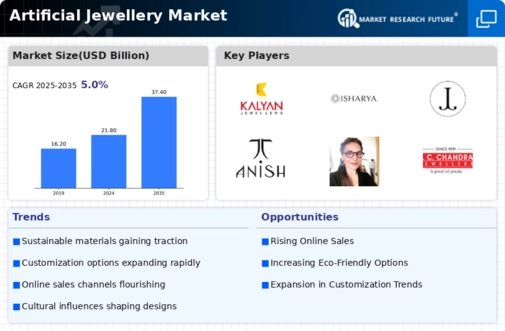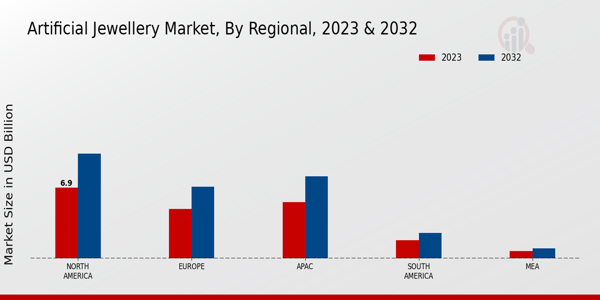Market Growth Projections
The Global Artificial Jewellery Market Industry is on a trajectory of robust growth, with projections indicating a market size of 21.8 USD Billion in 2024 and an anticipated increase to 37.4 USD Billion by 2035. This growth is underpinned by a compound annual growth rate of 5.04% from 2025 to 2035. Such figures suggest a burgeoning interest in artificial jewellery, driven by factors such as changing consumer preferences, sustainability concerns, and the rise of e-commerce. The market's expansion reflects broader trends in fashion and consumer behaviour, indicating a promising future for artificial jewellery brands globally.
Sustainability and Ethical Considerations
Sustainability has emerged as a pivotal driver within the Global Artificial Jewellery Market Industry. Consumers are becoming more conscious of the environmental and ethical implications of their purchases. Artificial jewellery, often made from recycled materials or ethically sourced components, appeals to this demographic. Brands that emphasize sustainable practices are likely to capture a larger market share as consumers increasingly seek products that align with their values. This trend not only enhances brand loyalty but also contributes to the overall growth of the market, which is expected to reach 37.4 USD Billion by 2035, indicating a robust shift towards responsible consumerism.
Innovative Designs and Customization Options
The Global Artificial Jewellery Market Industry is witnessing a surge in demand for innovative designs and customization options. As consumers seek unique pieces that reflect their personal style, brands are responding by offering customizable jewellery solutions. This trend is particularly pronounced in the online retail space, where consumers can easily design their own pieces. The ability to personalize jewellery not only enhances consumer engagement but also drives sales, as individuals are more likely to invest in items that resonate with their identity. This growing emphasis on customization is likely to contribute to a compound annual growth rate of 5.04% from 2025 to 2035.
Growing Consumer Preference for Affordable Luxury
The Global Artificial Jewellery Market Industry is experiencing a notable shift as consumers increasingly gravitate towards affordable luxury items. This trend is driven by the desire for stylish yet cost-effective alternatives to traditional jewellery, which often comes with a hefty price tag. As a result, the market is projected to reach 21.8 USD Billion in 2024, reflecting a growing acceptance of artificial jewellery as a viable fashion choice. This shift is particularly evident among younger demographics who prioritize both aesthetics and budget, thereby expanding the consumer base for artificial jewellery brands globally.
Expansion of E-commerce and Online Retail Channels
The Global Artificial Jewellery Market Industry is significantly benefiting from the expansion of e-commerce and online retail channels. The convenience of online shopping, coupled with a wide array of choices, has transformed how consumers purchase jewellery. This shift has been accelerated by advancements in technology and logistics, making it easier for brands to reach a global audience. As a result, the market is expected to see substantial growth, with projections indicating a rise to 21.8 USD Billion in 2024. The online retail landscape not only enhances accessibility but also allows for competitive pricing, further driving consumer interest in artificial jewellery.
Influence of Social Media and Celebrity Endorsements
Social media platforms play a crucial role in shaping consumer perceptions and preferences within the Global Artificial Jewellery Market Industry. Influencers and celebrities frequently showcase artificial jewellery, thereby enhancing its visibility and desirability. This phenomenon has led to a rapid increase in brand awareness and consumer interest, particularly among younger audiences who are heavily influenced by online trends. The strategic use of social media marketing has proven effective in driving sales and expanding market reach. As brands continue to leverage these platforms, the market is poised for sustained growth, reflecting the dynamic interplay between digital marketing and consumer behaviour.





















